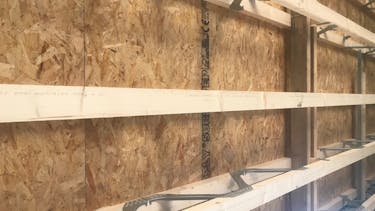
A first of its kind Timber Innovation Day was held at the start of the academic year at Dublin School of Architecture (prior to its incorporation into Technological University (TU) Dublin in January 2019).
The event celebrated innovation in timber construction and showcased a student-designed, student-built timber project made from MEDITE® TRICOYA® EXTREME (MTX).
The project was the culmination of the Institute’s partnership with St Mary’s Secondary School in Glasnevin under the Irish Architecture Foundation’s National Architects in Schools Initiative. This initiative aims to provide transition year students with first-hand experience of a complete architectural design process, under the guidance of architects and architectural graduates. It also aims to encourage sustainable construction practices and use of resources for future generations while bringing attention to the possibilities that come with using timber and wood products, such as MTX.
This year, participating 4th Year architecture students at Dublin School of Architecture and 4th Year pupils from St Mary’s designed a pavilion with a cross-frame structure that accommodated benches, planters and the ability to harvest rainwater, for use as an outdoor study and social spot in St Mary’s front courtyard. Though the project was the student’s responsibility, their teachers and lecturers offered guidance. The project was then built by German carpenter apprentices, who visit Dublin School of Architecture annually as part of an Erasmus+ mobility scheme, with the assistance of lecturers and architecture students.
“This was a very exciting project designed to inspire school children and undergraduates by giving them insights into how architecture is designed and built,” commented Joseph Little, Assistant Head of School at Dublin School of Architecture.
“Participating students from Dublin School of Architecture took on the role of a professional architectural practice, while St Mary’s pupils were effectively the clients. Each team was supported by their teachers and lecturers to come up with a working brief, a functional design, and to eventually build the pavilion that was exhibited at the Timber Innovation Day,” he explained.
“We’re very grateful for the insight of the German carpenters too. This is the third year they have visited us: each visit noticeably energises the engagement with timber in the School and their technical skills and insights are invaluable. They come for 2 weeks at the start of each academic year to learn about BIM, attend construction management lecturers, practice their English and engage in a building project with our students.”
“It was crucial that we went with MTX. I’ve been aware of MTX for some time, but I’ve never had the opportunity use it. For this project, it seemed to be a natural fit,” Joseph explained.
This, in part, was down to MTX’s resilience to the great outdoors. An organic process called acetylation allows this wood composite panel to achieve a level of weather and fungal resistance that means it’s guaranteed for external use for up to 50 years above ground, and 25 years in ground.
MTX can be cut, coated, coloured, sanded, glued, machined and fastened the same was as traditional MDF, and has the added benefit of extreme durability.
“This project is all about awakening the public and the future architectural workforce to the possibilities of building with sustainable, innovative, timber. The longevity of MTX as a material and the degree to which it is innovative meant it fitted the bill perfectly.
“MEDITE SMARTPLY and Coillte are also well-known names which resonate significantly within the Irish community as leaders in the environmental and creative fields. I have always admired them for this.”
A total of 40 boards in 9mm thickness were used for the project, the majority of which were donated by MEDITE SMARTPLY. Sheets of MTX were cut into frames by CNC router in the timber workshops of Dublin School of Architecture, which, together with bracing, formed the cross-frame structure of the pavilion. Engineers O’Connor Sutton Cronin kindly provided crucial support on fixing patterns.
“There is so much pressure to build with concrete and steel in the current building industry,” Joseph commented. “Many building design teams select these materials without considering timber and other wood -based products. This may partly be due to a lack of up-to-date support for timber specification in offices or the wider industry, but it must also relate to the kind of education architects, engineers and surveyors receive in college. We must remedy that in this generation. As timber is the only 100% sustainable mainstream structural material we have, both industry and education must re-orient to it to if we are to make the sustainable buildings that we clearly need.
“I believe we are at the very beginning of a cultural and technological revolution that will have sustainable and innovative Irish timber and timber products at its heart,” Joseph concluded our interview.
This link between sustainability and longevity is something MEDITE SMARTPLY are particularly passionate about.
“Maintaining a sustainable, pioneering approach to construction will ensure that MTX and other timber materials are around for future generations to utilise,” comments David Murray, Head of Innovation at MEDITE SMARTPLY.
“It’s fantastic to see MTX’s qualities being understood by younger generations as it is they that will help to shape future landscapes of Ireland and beyond. For them to understand the values of wood panels, and MTX in particular, at this stage in their careers is invaluable.”
The pavilion is to be presented to St Mary’s School at the end of this academic year.
Joseph Little was a practicing architect for over 20 years before joining Dublin School of Architecture at TU Dublin. His particular interest is sustainable building design.
Find out more about Dublin Institute of Technology here: www.dit.ie/architecture/studya...







